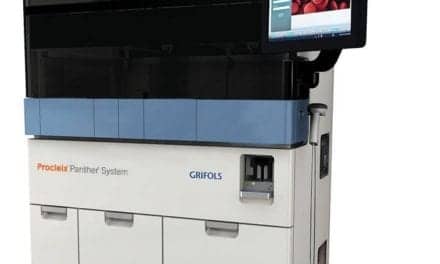The nanoelectronics and digital technologies research and innovation hub Imec, Leuven, Belgium, has unveiled a Genome Analytics Platform (GAP) that can perform a full genome analysis of 48 samples in only 48 hours—and at an acceptable cost. The platform paves the way for whole-genome sequencing to become a daily practice in hospitals for diagnosing and treating genetic diseases, including cancer and rare diseases, and for better treating newborns with complex disorders.
When the Human Genome Project was completed, in 2003, many in the scientific community and in vitro diagnostics industry agreed that it would be important to set and achieve the goal of performing whole-genome sequencing for the price of $1,000 per patient. They believed that when sequencing a patient’s genome cost only $1,000, it would become feasible to sequence the genome of every patient that needed it for better, more-personalized treatment.
Today, the $1,000 genome is nearly a reality. However, it has become clear that cost-efficient sequencing alone is not sufficient for realizing the promise of personalized medicine. Turning raw sequencing data into knowledge and information that is useful to physicians requires a lot of data storage and computing power. Previously, the cost of storing and analyzing such genomic data was considered too expensive and time-consuming for everyday use in hospital settings.
University researchers and industry leaders in Belgium, the Netherlands, and the United States have now tackled this genome analytics challenge, making the process of whole-genome sequencing cost- and time-effective for hospitals—not only for research purposes, but also for the treatment of patients in everyday care.
The newly developed solution consists of a combined ActiveScale Cloud object storage system and computing cluster from Western Digital, San Jose, Calif, which runs a heavily optimized version of the BlueBee Genomics Platform from BlueBee, Rijswijk, the Netherlands, and can also tap into Cloud-based resources as needed. The solution can process the full output of a next-generation sequencer (48 genomes) within 48 hours—the same time required for the sequencer to produce the raw genomic data.
“This Genome Analysis Platform project is one of several medical research initiatives Western Digital is supporting in the field of genomic analysis and precision medicine diagnoses at scale,” says Phil Bullinger, senior vice president and general manager for the data center systems business unit at Western Digital. “Enabling big data, analytics, and machine learning innovations is helping today’s medical research be more predictive, productive, and personal. It humbles us to be a part of such important and potentially life-saving initiatives.”
Western Digital’s ActiveScale system is scalable to 63PB of raw data in a single namespace, and provides up to 99.99999999999999999% data durability, providing the capabilities required to accomplish the extreme data-driven goals of Imec’s Genome Analysis Platform, now and in the future. Unified data access to the ActiveScale system enabled the platform architects to streamline the interaction between ActiveScale and the process for ingesting and analyzing massive amounts of genomic data. Western Digital nonvolatile memory express solid state drives sustain the velocity of data processing required to support the platform’s computing cluster for balanced system design.
There has previously been no real ecosystem or workflow available for clinical genomics, and discussions have been ongoing about whether local or Cloud computing offered the best solution. Imec’s new platform offers a hybrid solution that combines the best of both worlds: cost-effective analysis at a local site, and faster analysis involving Cloud computing.
Project partner Agilent, Santa Clara, Calif, has already integrated the hybrid platform into a first product, the Alissa OnePGT solution, a genomewide next-generation sequencing (NGS) system designed to integrate preimplantation genetic testing for monogenic disorders, translocations, and aneuploidies. The Alissa OnePGT solution is currently being tested by investigators at the University Hospital of Leuven and the human genetics group at Katholieke Universiteit Leuven (KU Leuven).
“Sequencing the whole genome of patients is important in rare-disease cases—we treat some 1,000 such patients every year—and for newborns, when decisions have to be made about their treatment,” explains Joris Vermeesch, PhD, professor and chair of the department of human genetics at KU Leuven. “If you can have a full picture of what is going on in the newborn’s body, by having a full genome map and indication of any genomic abnormalities, better decisions can be made about treatment. The same goes for prenatal surgery.”
“In the future,” Vermeesch adds, “when genome sequencing and analysis become even faster and more cost-effective, it is even thinkable that a whole-genome analysis would be performed for every patient.”
“This hybrid platform is a major step for the diagnosis and treatment of rare diseases,” says Yves Moreau, PhD, professor of engineering at the Stadius center for dynamic systems, signal processing, and data analytics of KU Leuven. “Our Genome Analysis Platform was made compatible with the Widely Integrated NGS (WINGS) platform, a system that can compare patient data from different hospitals, without revealing the patient’s identity. For rare diseases, this is the key to a successful diagnosis.”
“For now, the interface developed by Agilent, based on data from Cloud and local computing, needs to be analyzed by specialized doctors,” says Roel Wuyts, PhD, professor of computer science at KU Leuven and team leader for Imec’s ExaScience life lab. “However, in the future it is thinkable that artificial intelligence can help with the interpretation of the dataset, reporting the ‘lessons’ from your whole-genome sequencing and analysis to your doctor. Your doctor can then discuss the main messages and possible treatments with you.
“This whole cycle—from sample to sequencing to treatment options—should be possible to finish in only few hours,” adds Wuyts.
For further information, visit Imec.
Featured image: Image © Stepanenko Oksana courtesy Dreamstime (ID 107904063).




